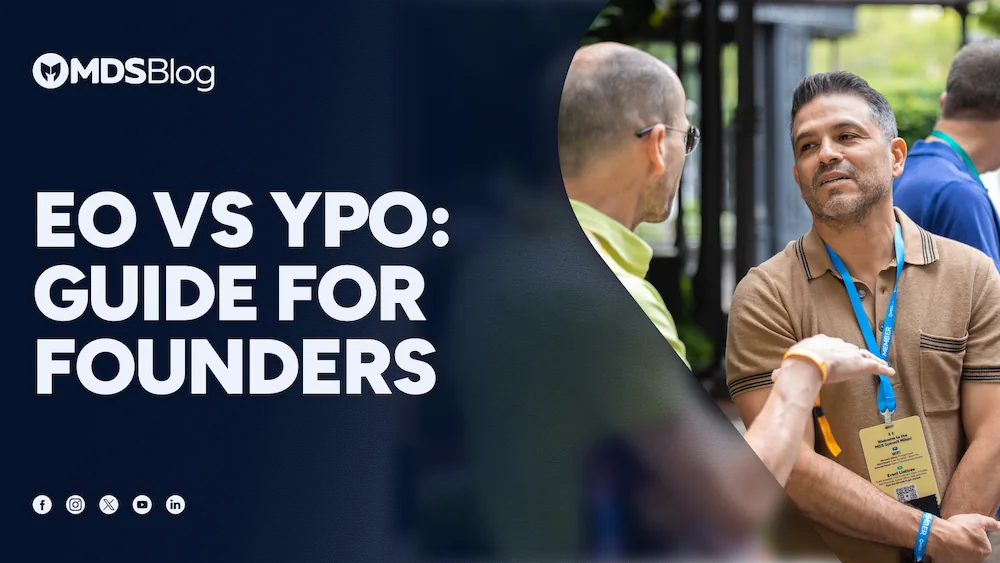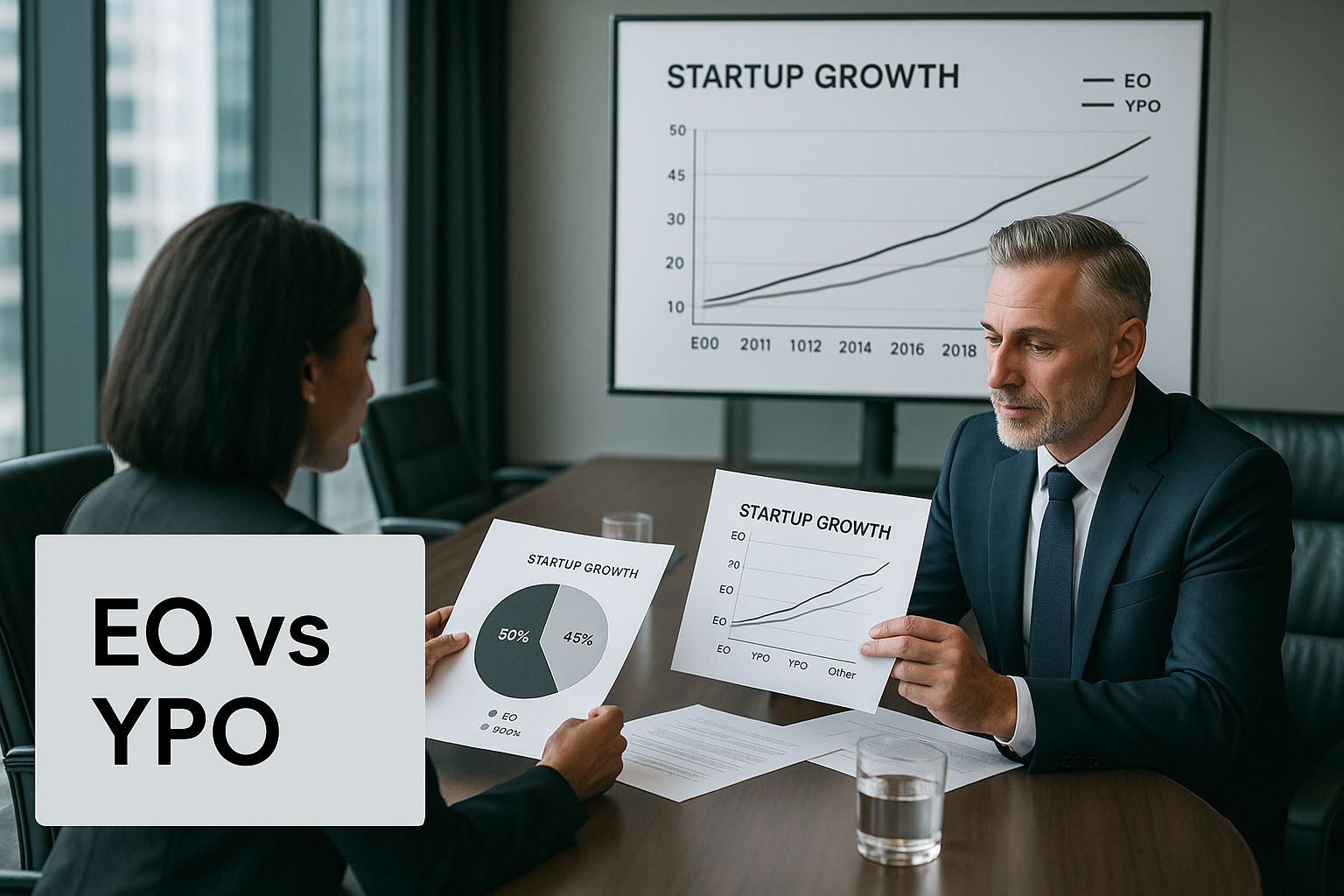Stay Updated with Everything about MDS
Thank you! Your submission has been received!
Oops! Something went wrong while submitting the form.

Chilat Doina
October 20, 2025
When you're trying to decide between EO and YPO, the conversation really boils down to one thing: scale. It’s the single biggest differentiator. The Entrepreneurs' Organization (EO) is built for founders who are deep in the trenches, actively scaling their businesses, and usually pulling in over $1 million in revenue. On the other hand, the Young Presidents' Organization (YPO) is the home for chief executives running much larger, more established companies—we’re often talking revenues north of $15 million.
So, your choice really depends on what you need right now. Are you looking for a peer group that understands the chaos of rapid growth, or do you need strategic advice on managing the immense complexity that comes with a much larger enterprise?
For any entrepreneur with big ambitions, picking the right peer network goes way beyond just making connections. It's about finding a genuine support system—a group of people who are wrestling with the same challenges you are and chasing similar goals. EO and YPO are both top-tier global networks that offer incredible peer-to-peer learning, but they are absolutely geared toward different stages of the leadership journey.
Getting clear on these differences is your first step toward making a smart investment in yourself and your business.
The Entrepreneurs' Organization (EO) kicked off in 1987 with a very specific purpose: to help founders navigate the tough, often lonely, path of building a business. Today, it’s a global force with over 16,000 members spread across 60 countries.
YPO has been around much longer, since 1950. Its focus has always been on younger chief executives who have already hit significant scale. It’s a massive network, with around 30,000 members in 142 countries. If you're interested in what's on the minds of CEOs at this level, this global leadership survey offers some fascinating insights.
To get a quick feel for where you might fit, it helps to see the core differences side-by-side. This table cuts straight to the chase.
CriterionEntrepreneurs' Organization (EO)Young Presidents' Organization (YPO)Revenue Minimum$1M+ annually$15M+ annually (varies by chapter)Typical MemberFounder, owner, majority shareholderCEO, President, Managing DirectorAge RequirementNoneMust join before age 45Core FocusScaling, entrepreneurial challenges, growth tacticsLarge-scale leadership, complex operations, global strategyOrganization SizeSmaller, growth-stage businessesMid-market to large enterprises
As you can see, the entry points and the typical member profiles are worlds apart. It’s not about which one is "better," but which one is the right fit for your current reality.
This infographic does a great job of visualizing the two distinct paths.

The image really drives home that while both organizations are about leadership, the scale of the businesses and the nature of the challenges discussed are fundamentally different. For a closer look at what membership entails, you might find our full breakdown of the Entrepreneurs' Organization helpful.
On the surface, the numbers seem straightforward: $1 million in revenue for EO, $15 million for YPO. But those figures are just the gatekeepers. The real difference between these two organizations lies in the details of who they’re built for, and understanding that is crucial before you even think about applying.
EO is laser-focused on the entrepreneur. To get in, you have to be the founder, co-founder, or a majority shareholder of a business with at least $1 million in annual revenue. This isn't an arbitrary rule; it’s designed to fill the room with people who have built their companies from scratch. The conversations here are about the grind, the growth hurdles, and the unique pressures that come with being the one calling all the shots.
Imagine a founder whose D2C brand just hit $1.2 million in sales. They're still deep in the weeds, making the day-to-day decisions that will make or break the company. That’s the quintessential EO member.
YPO, on the other hand, is playing a different game. It’s less about the startup journey and more about leading an established, complex enterprise. The $15 million revenue floor is just the starting point—many local chapters demand much more. This immediately shifts the focus from scrappy growth to managing significant scale.
YPO also has a few other hard-and-fast rules:
The core difference is role versus scale. EO is for the founder who built the machine; YPO is for the executive running a much larger, more complex machine, regardless of who originally built it.
Think of an executive who, at 42, became CEO of a $40 million company with 100 employees. Their challenges aren't about finding product-market fit; they're about corporate governance, international expansion, and managing multiple departments. That’s a YPO conversation. If you want to dive deeper into the specifics, our guide on YPO criteria breaks it all down.
Ultimately, where you fit isn't just about your top-line revenue. Your specific role in the company, your business model, and even your equity structure all play a part. Before you go down either path, take an honest look at where you and your business truly are right now.

Let's get one thing straight: the real magic of both EO and YPO happens in the Forum. It’s the absolute heart of the experience, far away from the glitzy events and big networking mixers. Think of it as your personal board of directors—a tight-knit group of 8-10 peers from non-competing industries who meet every month to tackle your toughest challenges in a 100% confidential space.
Both organizations rely on a structured, protocol-driven approach to make these meetings incredibly effective. You present your issues, and the group shares their direct experiences, not just fluffy advice. That distinction is everything. You're getting hard-won insights from people who've actually walked in your shoes, not just opinions from the sidelines.
But this is where the paths diverge. The feel of these conversations is worlds apart in EO versus YPO, and it all boils down to who is sitting around the table.
Inside an Entrepreneurs' Organization Forum, the air crackles with the energy of growth and scale. The members are founders and primary owners, typically steering companies in the $1 million to $10 million revenue range. They're still very much in the trenches.
The day-to-day conversation is grounded in the real, messy work of building a business.
An EO Forum is where you can talk about the raw, unfiltered reality of getting something off the ground. The feedback you get is practical, actionable, and meant to be used tomorrow. This is where you see the profound impact of mentorship and peer-to-peer learning in its purest form.
An EO member might say, "My lead developer just quit, and it feels like the whole product roadmap is about to collapse. I need to figure out my next move, fast."
The vulnerability is tied directly to the survival and scaling of the business itself. It’s a support system built for the builder.
A Young Presidents' Organization Forum operates at a completely different altitude. Here, you have members running companies with revenues from $15 million into the billions. The conversations naturally shift away from tactical execution and toward high-level strategy and complex leadership.
YPO discussions are more likely to center on the burdens of scale.
The YPO Forum acts as a strategic sounding board for the seasoned executive. The feedback is geared toward navigating the intricate political and operational chessboard of a large corporation. The stakes are different—it’s less about whether the business will survive the month and more about how it will dominate its industry and secure a legacy for decades.
Let's talk money. Joining EO or YPO is a serious financial commitment, and it's smart to think of it as an investment in your growth, not just another line item on your budget. But to do that, you need a clear picture of what you're actually paying for and what you can expect in return.
The membership fee you see on the website? That's just the starting line. Both organizations have initiation fees and annual dues, which can shift a bit depending on your local chapter. Generally speaking, YPO's fees are higher, which makes sense given the larger scale of their member companies and the global scope of their events.
But the real cost comes from showing up. The true investment is in the travel for regional conferences, global universities, and your forum retreats. These costs—flights, hotels, meals—can easily double or even triple your base membership fee each year if you're an active participant.
To really get to the bottom of the EO vs. YPO financial debate, you have to look at the whole picture. This isn't just about paying dues; it's about allocating capital toward your development as a leader.
Here’s a rough idea of what to expect:
The key isn't just the absolute dollar amount, but what that number means in the context of your business. A $15,000 annual commitment feels completely different to a founder running a $2M company versus one at the helm of a $50M enterprise.
Before we dive into the numbers, here's a quick comparison table to give you a clearer sense of the potential financial outlay for each organization.
An estimated financial comparison of joining and participating in EO versus YPO.
Cost ComponentEO (Estimated Range)YPO (Estimated Range)NotesInitiation Fee$2,500 - $4,000$4,000 - $10,000One-time fee, varies by local chapter.Annual Dues$2,500 - $5,000$4,000 - $15,000Covers local and global membership benefits.Forum Retreats$500 - $2,500 per retreat$1,000 - $5,000 per retreatTypically 1-2 per year, costs vary by location.Local/Regional Events$250 - $1,500 per event$500 - $3,000 per eventCost depends on the scale and location of the event.Global Events$3,000 - $10,000 per event$5,000 - $20,000+ per eventIncludes flagship "Universities" and summits.Total Annual Est.$6,000 - $20,000+$10,000 - $40,000+Heavily dependent on your level of participation.
Remember, these are just estimates. The real cost comes down to how much you decide to lean in and participate.
The ROI conversation looks completely different for each group because their members are simply playing in different financial leagues. This is especially true if you look at how founders pay themselves. Research has shown that smaller companies spend proportionally way more on executive pay—up to 41 times more of their revenue—than the biggest corporations. You can explore more about these executive cost ratios to really understand the data.
What does this mean in practice? The typical EO founder, who's running a smaller but growing business, probably has a much tighter cash flow, both personally and professionally. For them, the ROI needs to be tangible and happen fast. Getting one piece of advice in their Forum that helps them avoid a $50,000 operational mistake or unlocks a new marketing channel provides a clear, immediate return on their investment.
On the other hand, a YPO member leading a much larger company usually has a bigger compensation package and access to a corporate budget. The ROI they're after is often more strategic and long-term. They might be looking to forge a global partnership or gain an insight that helps them navigate a tricky board situation. The financial payoff is measured on a much grander scale, which makes the higher membership cost a justifiable investment for a different kind of strategic gain.

While your Forum is the constant pulse of the experience, the global events are where you truly grasp the scale and power of these networks. Forget everything you know about typical industry conferences. These are meticulously produced, immersive experiences designed to connect you with world-class ideas, people, and cultures.
That said, EO and YPO come at learning from two fundamentally different places.
EO’s events—often called "Universities" or large regional conferences—are built for the founder in the trenches. The programming is intensely practical, zeroing in on actionable strategies you can use to scale your business now. You'll find yourself in workshops on advanced digital marketing, operational excellence, or building a high-performance sales team.
The entire point is to send you home with a brain full of ideas and a notebook full of tactics you can put to work first thing Monday morning. An EO event is about solving today's growth problems.
YPO, on the other hand, plays a different game. Its events take a much broader, more strategic view. The focus shifts from the tactical "how-to" of running a business to the "what's next" of global trends, leadership, and personal development. You’re not just learning new business plays; you're developing a new worldview.
Leveraging its immense prestige, YPO pulls off some truly mind-blowing experiences. The access is just on another level. This often means:
A YPO event aims to expand your perspective as a global citizen and leader, not just to fine-tune your skills as an operator. The value is in strategic foresight, not immediate operational tweaks.
The core distinction is one of application versus perspective. EO equips you with a better toolkit to build your business today. YPO provides you with a better map to understand the world your business will operate in tomorrow.
For an e-commerce founder, this is a crucial distinction. If your biggest hurdles are mastering customer acquisition or optimizing your supply chain, EO's events deliver more immediate, tangible value. But if you’re wrestling with international expansion, complex corporate governance, or long-term positioning in a volatile market, YPO's 30,000-foot view is far more relevant.
It all comes down to what you need most right now: a wrench or a telescope.
Choosing between EO and YPO isn't about which one is "better." It's about fit. The right network for you comes down to your current business stage, the kinds of problems you're wrestling with, and what you’re trying to achieve personally. This means taking an honest look at where you are today and where you plan to go next.
Think of it like picking the right tool for the job. If your company is pulling in $5 million a year, your world probably revolves around aggressive growth and scaling your operations. You need to talk to people who are in that same fight—people who can give you real-world advice on hiring your first C-suite exec, making your ad spend work harder, and not running out of cash. That's EO's sweet spot.
Now, flip the script. Imagine you’re running a $50 million e-commerce brand. Your challenges look completely different. You’re not trying to find product-market fit anymore; you're figuring out international logistics, managing a senior leadership team, and dealing with the headaches of corporate governance.
At this level, you need advice from founders and CEOs who’ve managed businesses of that size and complexity. The kind of large-enterprise experience you find in YPO is perfectly suited for those sophisticated challenges.
The EO vs YPO debate is really a stand-in for a more fundamental question: Are you still building the engine (EO), or are you now steering the massive ship it has become (YPO)? Answering that with total honesty is the key.
To get to the right answer, run your situation through this simple filter:
Both organizations are incredibly powerful, but they serve different purposes. Knowing these nuances is the first step toward finding effective business mastermind groups that will actually help you move the needle. When you match your specific needs to what each network does best, you can be confident you're investing your time and money in the right place.
When you’re weighing two powerhouses like EO and YPO, a few specific questions always seem to pop up. Let's get straight to the answers you need to make the right call for your journey.
Technically, yes—if you somehow meet the demanding criteria for both. But in reality, it's incredibly rare and most seasoned members would advise against it.
Think about it: the real magic of these groups is the deep immersion in your Forum and chapter. The commitment—time, money, and sheer mental energy—is substantial for just one of them. Trying to do both would mean spreading yourself too thin, and you'd likely miss out on the deep, trust-based relationships that make these networks so valuable in the first place.
YPO has a clear and respected path for this. When a member reaches 50, they don't get kicked out; they "graduate" into YPO Gold.
This is essentially the alumni network, designed to keep the community going for life. YPO Gold provides its own exclusive events, networking opportunities, and even Forums tailored to leaders who are often entering a new phase of their life and career. It’s a continuation, not an end.
This is a nuanced question. Both EO and YPO have very strict non-solicitation rules. You can't just walk into a meeting and start pitching your business—that would kill the open, peer-support vibe instantly.
However, connections happen organically. From what I've seen, EO tends to be a fantastic place for finding tactical partners—think shared operational challenges, finding a great marketing agency, or getting advice on scaling a specific channel. On the other hand, because of its members' scale, the YPO network is more likely to lead to high-level strategic alliances or introductions to potential board members. Just remember, direct fundraising is a no-go in both.
For e-commerce founders looking for a community built on actionable strategies and deep industry expertise, Million Dollar Sellers offers an exclusive, curated network. Connect with top sellers and scale your business faster.
Join the Ecom Entrepreneur Community for Vetted 7-9 Figure Ecommerce Founders
Learn MoreYou may also like:
Learn more about our special events!
Check Events